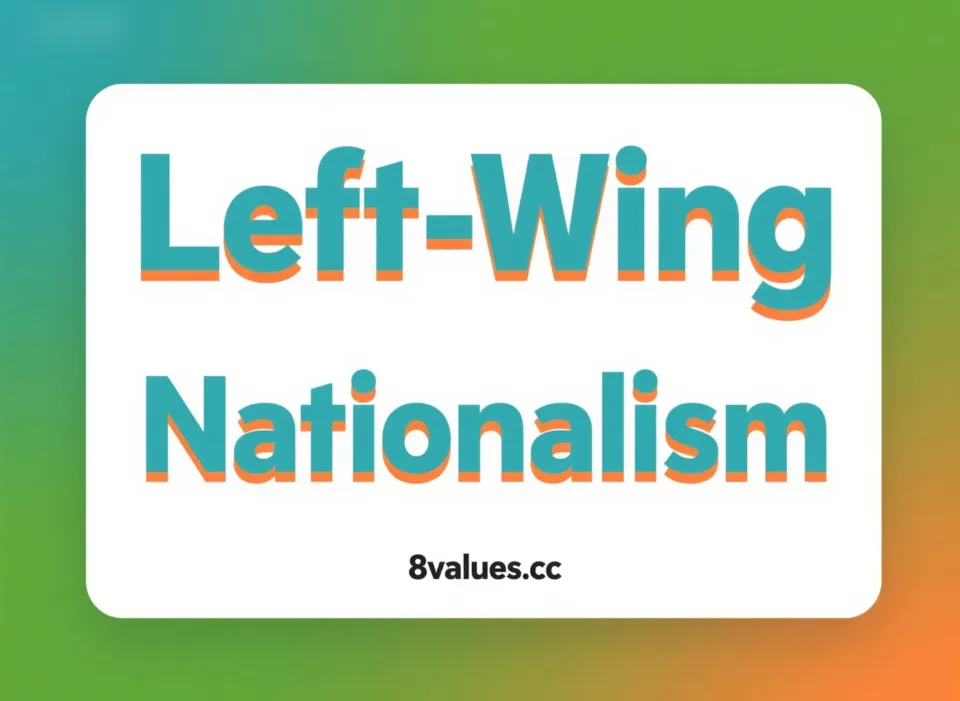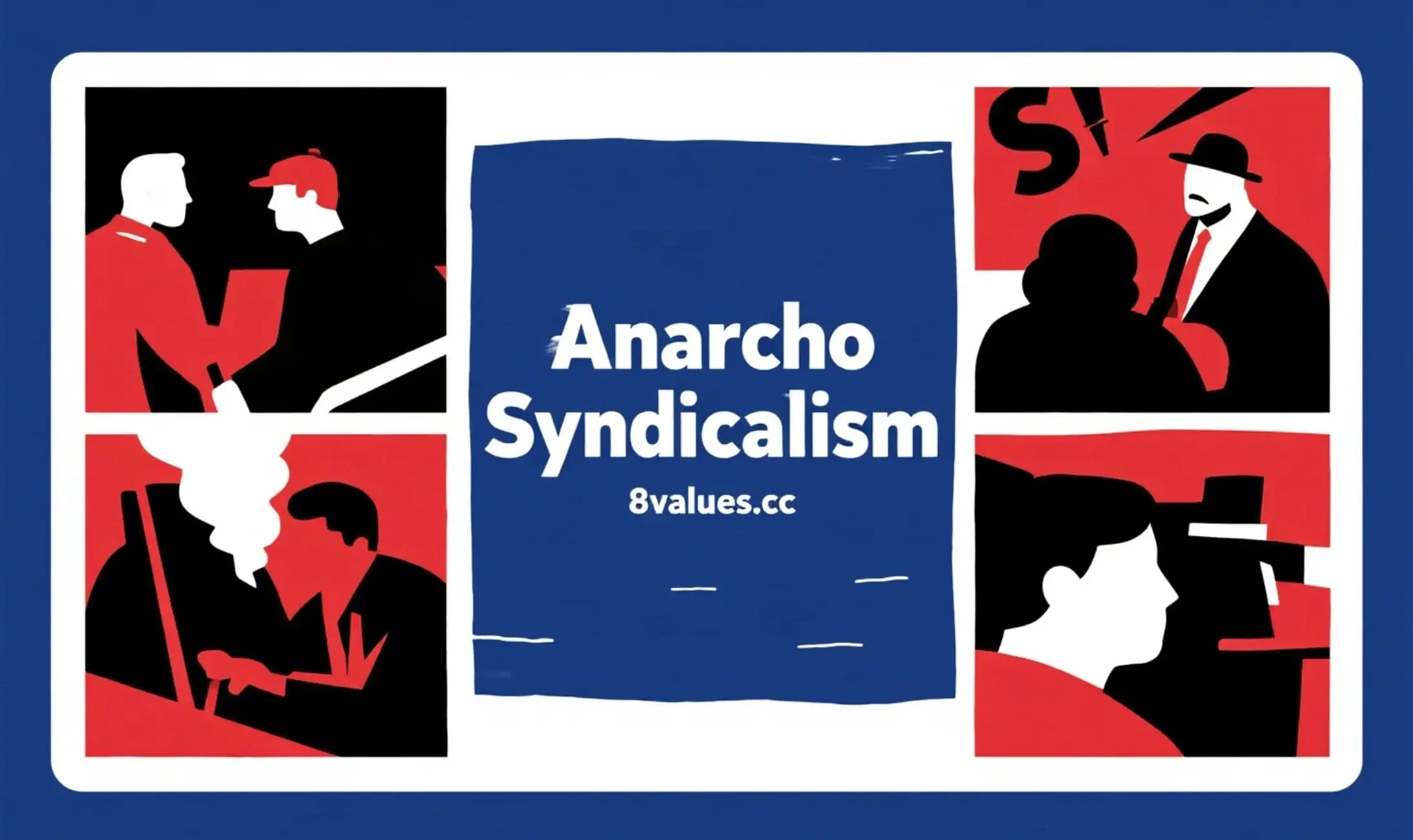Left-Wing Nationalism: an ideology that pursues national liberation and social equality
Left-Wing Nationalism is a political trend that combines national self-determination, anti-imperialism and demands for social equality. It emphasizes national sovereignty, opposition to external oppression, and domestic commitment to economic justice and labor protections, often in sharp contrast to the nationalist right and the traditional internationalist left.
Left- Wing Nationalism , also known as popular nationalism or social nationalism (Social Nationalism) in some contexts, is a form of nationalism based on left-wing political positions such as national self-determination , popular sovereignty , and social equality. This ideology is often contrasted with right-wing politics and right-wing nationalism.
Left-wing nationalism often includes anti-imperialist and national liberation movements . Its core idea is to combine demands for social equality with national interests and national self- determination, and to oppose the double injustice of external oppression and internal exploitation. If you'd like to explore your political values, try taking the 8Values Politics Test .
The core proposition of Left-Wing Nationalism
Left-wing nationalism is not a single fixed ideology, but a collection of common ideas. Its core features are reflected in the dual emphasis on "equality" and "nation."
National level: fight against oppression, emphasize self-determination and sovereignty
Left-wing nationalism advocates that national independence is the prerequisite for getting rid of imperialist oppression and achieving social liberation. It opposes colonialism, imperialism, or control of the country's economy and politics by outside forces.
- Anti-oppressive : Opposing all exploitation and oppression, especially imperialism and colonialism, such as supporting left-wing nationalist practices in anti-colonial struggles such as Ho Chi Minh in Vietnam and Castro in Cuba.
- Economic sovereignty : Emphasizes the protection of national culture, resources and the interests of ordinary people, rather than the interests of transnational capital or foreign governments. Left-wing nationalists reject neoliberalism and supranational intervention entirely or to a large extent.
Social level: pursue equality and oppose exploitation
Left-wing nationalists tend to view the state as a tool to achieve social justice and combat external oppression .
- Economic equality : Adhere to the left-wing principle of equality and advocate narrowing the gap between rich and poor through government intervention, protecting labor rights and providing public welfare.
- Nationalization and Welfare : They work to reduce the gap between rich and poor in the country and advocate retaining or nationalizing public services such as health, energy, and public transportation.
- Group tolerance : usually emphasizes class unity within a nation and downplays racial or religious differences. Although it emphasizes national identity, left-wing nationalism usually does not reject multiculturalism , which is different from the xenophobic and racist tendencies of right-wing nationalism.
Marxist interpretation and criticism of nationalism
In order to deeply understand the positioning of left-wing nationalism in the political spectrum, we must analyze it within the framework of traditional left-wing thought, especially orthodox Marxism .
Classical Marxism’s definition of nation
Classical Marxists agree that nationalism is a bourgeois phenomenon , generally unrelated to Marxism.
- Social and economic construction : Marxism views nation as a social and economic construction formed after the collapse of the feudal system and used to establish a capitalist economic system.
- Historical process : Karl Marx and Friedrich Engels explained the issue of nationality on the basis of social evolution. They believe that the emergence of modern nation-states is the result of the replacement of feudalism by the capitalist mode of production. Capitalists seek to unify and centralize the culture and language of the population within the country in order to create conditions conducive to a market economy.
- State and Society : Although Marx and Engels believed that the origins of nation-states and national identities were bourgeois in nature, they also believed that the establishment of a centralized state created positive social conditions that promoted class struggle . Marx once pointed out in "The German Ideology" that civil society includes all material interactions between individuals at a specific stage of development. It transcends the state and nation to a certain extent, but on the other hand, it must maintain itself in the form of nationality in external relations and organize itself as a state in internal relations.
The position of nationalism in class struggle
Marx and Engels assessed specific peoples, arguing that certain nationalisms were progressive (because they helped to destroy feudalism), while those considered detrimental to the development of the international class struggle were reactionary and must be eliminated.
- Proletariat and nation : In "The Communist Manifesto", Marx once stated: " Workers have no motherland . We cannot deprive them of what they do not have. Since the proletariat must first seize political rule, rise to the leading class of the nation, and organize itself into a nation , then it itself is still national for the time being, but it is by no means a nation in the bourgeois sense."
- Internationalism first : Marx generally preferred internationalism and advocated interaction and cooperation among nations in class struggle. Proletarian internationalism asserts that members of the working class should unite with working people in other countries to pursue common class interests rather than focusing solely on their own country. This was summed up by the slogan "Workers of the world, unite!" (Workers of the world, unite!). The traditional international left advocates transnational class cooperation , and its ultimate goal is to "eliminate the state."
Stalinism and revolutionary patriotism
In the Soviet Union under Stalin, he promoted a concept of civic patriotism called revolutionary patriotism .
- Patriotism within the context of class struggle : Stalin supported an interpretation of Marx that allowed the use of proletarian patriotism within an internationalist framework to promote class struggle.
- Changing views on the nation : Stalin was involved in the Georgian nationalist movement in his early years. However, after becoming a Bolshevik, he once strongly opposed national culture and denounced the origin of contemporary nationality as bourgeois. He defined nation as “not a race or a tribe, but a historically formed community.” However, after the outbreak of the German-Soviet War, Stalin frequently mentioned patriotism in his speeches in the Soviet Union.
Marxist criticism of left-wing nationalism
The common ground between left-wing nationalism and the traditional internationalist left is the pursuit of social equality and opposition to capital exploitation, but they have fundamental differences on whether the core of identity is nation or class.
- The role of the state : Left-wing nationalism recognizes the positive role of the state and regards it as the carrier of "protecting national interests." Traditional Marxism believes that "the state is a tool of class rule."
- Conflict of priorities : For some critics, left-wing nationalist narratives risk undermining the universality of class emancipation, focusing on “ lifting domestic people out of poverty first and then talking about international cooperation ” rather than “uniting workers around the world.”
Types and practical cases of left-wing nationalism
Left-wing nationalism is not a single ideology, but appears in different guises across the global political spectrum, which makes the analysis of political tendencies more refined. If you want a deeper dive into your ideology, you can try a multi-dimensional test like the 9Axes Politics Test .
1. Social Democratic Nationalism
This is an idea that combines social democracy with nationalism. It is generally more moderate on labor and economic issues than principled socialism in the narrower sense.
- Characteristics : Widely spread in developing countries and parts of Europe. For example, the Slovak party “Direction – Social Democracy” (Direction – Social Democracy) supported a moderate social democratic nationalist concept in the 2020s, which was manifested in an explicit rejection of immigration.
2. Social Ethno-nationalism
This doctrine aims to promote social progress while defending the racial interests of different peoples, including both liberation and supremacy.
- Example : In the United States, black nationalism , which aimed to defend the interests of African Americans, was influential in the 1970s, such as the Black Panthers Party. In South America, Indigenismo is based on defending the national interests of Native Americans while promoting social progress and wealth sharing.
3. Socialist Nationalism
The concept refers to combining socialism with nationalism or some form of national sentiment. It contrasts with the internationalism of Marxist socialism.
- Non-Marxist influences : The term is usually applied to certain non-Marxist variants of socialism, such as Argentinian Peronism , Pan-Arab Nasserism , and Ba'athism .
- Independent forms influenced by Marxism : such as Sandinismo in Nicaragua and Chavismo in Venezuela, which were influenced by Marxism but were independent of its principles. Chavismo is considered the representative form of socialist nationalism, emphasizing "21st century socialism."
4. Progressive Nationalism
This type is considered a major trend in left-wing nationalism in the United States (such as Theodore Roosevelt's New Nationalism ) and South Korea.
- Characteristics : Progressive nationalists believe that social and cultural innovation must be achieved through resistant nationalism. The "New Nationalism" platform promoted by Theodore Roosevelt in his 1912 presidential campaign combined his traditional progressive policies (such as antitrust legislation, universal health care, direct democracy, and women's suffrage) with American nationalist policies (such as support for naval construction).
Reflection in the independence movement
Left-wing nationalism was particularly prominent in movements against colonial rule and for national liberation, such as:
- Irish republicanism : Irish nationalism has had elements of left-wing nationalism since its mainstream formation. Parties such as Sinn Féin, for example, advocate national self-determination while also supporting social democratic policies.
- Scottish Independence Movement : The Scottish National Party (SNP) has been on the center-left since the 1970s, combining the independence movement with left-wing egalitarian politics, aiming to achieve a socialist Scotland through independence.
- Separatist movements : In regions such as Spain's Basque Country and Catalonia , left-wing nationalists have played an important role in leading autonomy and secession movements.
Comparison between left-wing nationalism and major political trends
Left-Wing Nationalism clearly distinguishes its similarities and differences from other major political trends through its core appeal—the combination of national interests and social equality . If you are interested in the nuanced spectrum of left-wing thought, I recommend taking a look at the LeftValues political test .
Confrontation with right-wing nationalism
Both take "nation" as the core of their identity, but they are fundamentally opposed on key issues such as social distribution, group inclusion and state functions.
| Contrast Dimensions | Left-Wing Nationalism | Right-Wing Nationalism |
|---|---|---|
| social equality | Pursue economic equality, oppose capital exploitation, and advocate high welfare and labor protection. | Maintain the existing social hierarchy, oppose welfare expansion, and believe that inequality is the result of competition. |
| group inclusion | Emphasizes class unity within the nation and usually downplays racial and religious differences. | It is often tied to racism and xenophobia, emphasizing "the superiority of one's own nation" and excluding immigrants or ethnic minorities. |
| national functions | The state is a tool to achieve social justice and fight against external oppression. | The state is an authoritative symbol that maintains national honor and order, emphasizing power and centralization. |
Conflict with the traditional internationalist left
Both pursue social equality and oppose capital exploitation, but there are fundamental differences in whether the core of identity is ethnicity or class.
| Contrast Dimensions | Left-Wing Nationalism | Traditional internationalist left (e.g. classical Marxism) |
|---|---|---|
| core identity | Taking ethnic groups as a unit, priority should be given to safeguarding the equality and interests of the country/ethnic group. | Taking class as the unit, we advocate "international proletarian unity" and transcend national boundaries. |
| treat the country | Recognize the positive role of the state and regard it as a carrier of "protecting national interests." | It believes that "the state is a tool of class rule" and the ultimate goal is to "eliminate the state." |
| External attitude | Oppose the oppression of the country by "external forces (such as imperialism and foreign capital)". | Oppose the exploitation of the proletariat of all countries by "global capital" and advocate transnational class cooperation. |
Opposition to liberalism
The core of liberalism is "individual freedom" and "market freedom," which are almost completely opposite to the left-wing nationalism's core demands of "social equality" and "national interests first."
- Freedom and equality : Left-wing nationalism prioritizes "equality" and is willing to sacrifice some market freedoms in exchange for social fairness. Liberalism, on the other hand, prioritizes "individual freedom" and believes that equality must give way to free competition.
- Market and government : Left-wing nationalism advocates government intervention in the market to protect domestic industries and workers. Liberalism advocates "small government, big market" and opposes government interference in economic freedom.
- External attitude : Left-wing nationalism supports trade protection and restrictions on foreign capital, and safeguards national economic sovereignty. Liberalism supports free trade and free flow of capital and advocates "global integration."
Differences from left-wing populism
The two political trends, Left-Wing Nationalism and Left-Wing Populism, both incorporate left-wing progressive demands and specific political mobilization strategies, but there are significant differences in core goals, mobilization logic, and practical paths.
| Contrast Dimensions | Left-Wing Nationalism | Left-Wing Populism |
|---|---|---|
| Core Focus/Main Objectives | It combines the demand for socialist equality with national liberation, takes national liberation as the core, and emphasizes national self-improvement and international anti-hegemony . | Focusing on domestic class contradictions and anti-elites , using the "people vs. capital" framework as a framework, it emphasizes social equality and anti-establishment . |
| Main conflict/narrative frame | Anti-imperialism and anti-colonialism oppose external oppression and emphasize the freedom of oppressed nations from the control of external forces. | Focus on the antagonism between "the people" and "elites"/"capital", such as the demands for economic equality in the Sanders movement in the United States. |
| economic proposition | It emphasizes economic sovereignty , advocates the redistribution of resources through state intervention , and opposes the interests of transnational capital or foreign governments. | It emphasizes the radical nature of policies and advocates direct democracy and welfare expansion , but it may be easily simplified into the slogan of "equalizing the rich and the poor". |
| Mobilization strategies/vehicles | Recognize the positive role of the state and regard it as a carrier of "protecting national interests" and "achieving social equity." The core of mobilization is sovereignty struggle . | Mobilization relies on mass mobilization to appeal to marginalized groups through emotional narratives . |
| international position | Advocating national liberation must be based on the liberation of other weak and small ethnic groups , supporting the joint liberation of weak and small ethnic groups, and avoiding exclusivity. | By emphasizing domestic issues, it is easy to focus on “getting your own people out of poverty first, and then talk about international cooperation.” |
| Potential risks | Nationalism implies the logic of " national supremacy ", which is in tension with the left's class liberation, and may ignore internal class oppression ; in practice, it may slip towards statism . | Easily co-opted by the establishment ; mobilization strategies may slide toward populist authoritarianism . |
| Typical cases | The Cuban revolution, the Vietnamese independence movement, and “Bolivarian socialism” in Latin America. | Sanders movement in the United States. |
Conclusion: The political positioning and risks of left-wing nationalism
Left-wing nationalism is an ideology that combines national liberation with social justice. It emphasizes that national independence is not the end, but the starting point for the realization of socialism . This ideology has historically provided a framework for mobilization and resistance for colonized and oppressed peoples.
However, this ideology is not without controversy. Critics point out that in practice, it may slide towards statism or national socialism , especially in the "center countries", and may evolve into a tool of external national oppression. This theoretical tension, that is, the contradiction between the "national supremacy" logic implicit in nationalism and the liberation of left-wing classes, may lead to an eventual tendency towards state capitalism . Therefore, the legitimacy of left-wing nationalism depends on whether it adheres to the progressive background of anti-oppression, rather than purely nationalist demands.
If you want to explore more detailed classifications and explanations of political ideology, welcome to visit the official blog of the 8Values Political Ideology Test official website .






